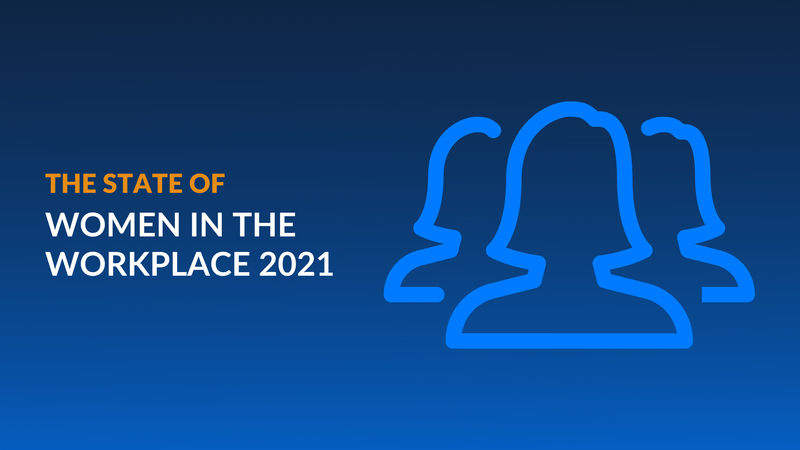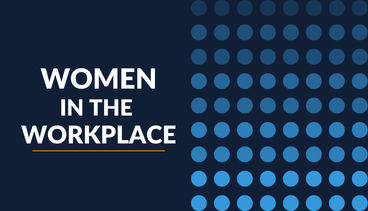
The State of Women in the Workplace 2021
Posted on 03/08/21 By Brittany K. King
Women make up more than 50% of the United States population and nearly half of the total U.S. labor force. Despite this, women continue to be underrepresented, underpaid, discriminated against in the workforce.
But just how unequal is the treatment of women in today's workforce? And what can we do to help combat it?
Below is a rundown of the state of women in the workforce in 2021 and ways individuals and organizations alike can combat gender bias in the workplace.
The Gender Pay Gap
The gender pay gap, or gender wage gap, depicts the average difference between the compensation for men and women who are working.
There have been countless efforts to combat the pay gap over the years. In 1963, the Equal Pay Act went into effect, making it illegal to pay men and women different wages for fundamentally equal work within the same establishment.
Despite attempts for gender equity in the workforce, there is still a lot of work to be done in the battle for true equality.
On average, women earn less compared to every dollar a man makes. This is determined by two distinct numbers: the controlled and uncontrolled pay gap.
The uncontrolled group measures the median salary for all men and all women. The controlled group measures the median salary for men and women with the same job and qualifications.

Women in the Workplace Statistics
The coronavirus pandemic has had a negative impact on the workforce as a whole, but women especially. Statistics show the number of women in the workforce has significantly dropped since the beginning of the pandemic in early 2020.
275,000 women left the labor force in January 2021, accounting for nearly 80% of all workers over age 20 who left the workforce that month.
This means that since the onset of the pandemic in February 2020, more than 2.3 million women have left the labor force, compared to nearly 1.8 million men who left in the same time frame.
This means that currently, women’s participation in the workforce is at 57% — the lowest it has been since 1988.
Percentage of Women in the Workforce
The inequities experienced by women in the workplace are shocking, as seen by the below statistics:
- Women represented 47% of the total labor force in 2019.
- 57.4% of women participated in the labor force in 2019, compared to 69.2% of men.
- Women are more likely to lose their jobs due to automation by some estimates.
- 58% of workers in the most at-risk jobs are women.
- For every 100 men promoted to manager, only 85 women were promoted.
- At the beginning of 2020, women held 38% of manager-level positions, while men held 62%.
- The 2020 Fortune 500 list revealed a record high number of 37 women CEOs, compared to the 463 CEO positions held by men.

Women of Color in the Workplace
In 2019 people of color made up nearly 40% of the population. However, people of color continue to face bias in the workplace.
And women of color especially experience extreme inequity in the workforce.
- For every 100 men promoted to manager, only 58 Black women and 71 Latinas were promoted.
- 1 in 3 Latinas work in a high-risk field.
- Men held 77.5% of Fortune 500 board seats in 2018, while women held 22.5%. But only 4.6% of these seats were held by women of color.
- Men held 74% of S&P 500 board seats while women held 26%. In the top 200 companies in the S&P 500 board seats, only 6% were held by women of color — 4% by Black women, 1% by Latinas, and 1% by Asian women.
Women of color are more likely to stagnate in their career than white women. They are also more represented in individual contributor roles and the least represented higher up on the corporate ladder.

9 Ways to Combat Discrimination of Women in the Workplace
Nearly 50% of survey women said an organization’s stance on gender equality will affect their job search and decision.
So how can you actively combat gender discrimination in the workplace?
We spoke with thirteen women who shared what they believe is important for females to have in the workplace and how their companies work toward equality.
1. Encourage Collaboration
“Gender discrimination will continue to happen without ongoing work to build policies, practices, and legal repercussions for when it does happen. Without an ongoing collaborative presence by all women (not just some women), rights in the workplace will be repressed.
This isn’t just about the discrimination we can see, but also about what we feel, what pressures us to quit our jobs when pandemics or other world and economic issues arise.
It is about taking a holistic view of discrimination and oppression in the workplace.
Even in my 30s, I don't know that I’ll see a world where I am equal, but that doesn't stop me from fighting for it for others.”
2. Seek Support from Other Women
"In my 30+ year career in technology, I've been a first-hand witness to the evolution of gender bias and discrimination in the workplace. Big tech in the U.S. still tends to be dominated by a majority-male workforce, but women have found their footing on mostly-equal ground in the past decade or so.
I started my career in 1990, and the gender gap at that time was visible even in the dress code. Men were permitted to wear most anything they wanted, provided their pants pockets weren’t on the outside (yes, that was real!), but women had a whole host of wardrobe rules to comply with, including a requirement to wear pantyhose or tights when wearing a dress or skirt. Even then, it was clear that women were treated differently in the workplace — held to a different standard.
Over the years, I saw this gap tighten, as women began to influence the ground rules.
By 2000, there was a palpable shift. I was fortunate to work for a company that strove to promote equality and diversity. By mid-career, I no longer felt as if there was any disadvantage to my gender within my company.
I know not all companies made the same strides. Even today, gender inequality in the workplace is unacceptably pervasive. Every industry has networks you can connect with if you look. There are dozens of thriving networks for women in technology and participating in a network that’s meaningful to you is an excellent way to seek out other women to help guide you and lift you up.
I’ve made connections in these networks that have lasted years, met women whom I’ve eventually mentored, and women who have mentored me.
The experience of a woman in your field will not be the same as a man's. It's invaluable to seek out women who have successfully carved a career path and can offer you guidance and support on your own journey. LinkedIn is an outstanding resource to find these networks for women.
Don’t be afraid to reach out and network with women whose careers you admire and seek out their mentorship. Mentor relationships can be quite rewarding for both women and can help broaden both of your networks."
3. Practice Empathy
"As a female co-founder in the consumer goods market, I understand the complex issues women may face in finding the right opportunities to match their talents.
The most important thing organizations can do to attract and retain talented women is to admonish sexism and offer gender parity in pay, experiences, and opportunities for success.
Being one of three founders, the other two male, we have a collective understanding of the important role women play in improving a company’s performance and adhere to these principles in maintaining a fair and balanced environment.
Women are able to relate through empathy and appreciation for others since they are typically more focused on individuals and their needs. This greater willingness to communicate and receive feedback contributes to problem-solving strategies and positive resolutions.
Overall, women want to have personally meaningful work that connects to their values, purpose, and work-life balance. This means flexibility and a career that caters to their calling, allowing for growth and further development with the potential for promotion and lasting satisfaction.
Comprising a work environment that allows for this results in successful outcomes on all levels. In general, when women and men receive equal opportunities in the workplace, everyone benefits."
4. Elevate Female Voices
"At JazzHR, one way we empower women is by elevating their voices. In our daily conversations, company-wide meetings, and strategic discussions, we champion female colleagues by recognizing their ideas, accomplishments, and unique perspectives. Women's voices are not just acknowledged but heard in our organization.”
"Aside from the obvious issues like gender pay gaps and maternity discrimination, women still lack powerful, upper-tier female role models.
Men often benefit from a wealth of mentors, while women shy away from being 'taken under a wing' if its a male boss due to stigma.
Women in managerial roles need to be more proactive and coach other women towards career progression and success. We have more power than we know!"
5. Provide Equal Opportunities
"Like what every worker wants, women want fairness in the workplace- not just in pay, but providing them with equal opportunities to showcase their skills and allow them to make a difference.
Where I work now, they value the voice of the women. They empower women by recognizing our ideas and encouraging us to pursue opportunities for career advancement."
“Being a female, 20-something first-time founder was a major obstacle for me early in my career. Unfortunately, these attributes can deter investors, making it more difficult for companies to receive pre-launch funding.
I combatted this by gaining both capital and proof of concept through a Kickstarter campaign that was fully funded within 24 hours.
A person’s gender-bias can’t argue with clear, compelling data proving there is demand in the marketplace for the product or service you have created.”
6. Develop More Female Leadership
“I am a female founder and I’ve noticed a huge gender gap in the executive branch - specifically in CEO and CTO roles.
The lack of diversity in leadership is something I work hard against. That’s why I make it a priority to hire women to lead my teams and provide mentorship for women to advance their careers.
I believe women in the workplace deserve respect and opportunities. It is important not to tokenize women or minorities, but instead, create a workplace that supports diversity through equal opportunity.
I have created my own women networking group through the women professionals I have met. It’s not just about being on the lookout for opportunities to empower women but creating your own.
Bottom line: I empower women in the workplace by hiring women in leadership roles, providing mentorship, and creating my own network of female professionals.
Insider tip: Don’t wait for opportunities to emerge, create your own!”
"Women want to be viewed as equals, we want to see more women in executive roles, and we want to see more strong female leaders, it's tough to look up the ladder at large groups of men, as it can often feel unattainable, organizations could be conscious of the development of the women in the business, and ensure that we all, both men and women, feel empowered that those opportunities are available to us if we want them enough.
I feel quite comfortable within EposNow as a woman, HR is a typically female dominated field, but it is not here which is new to me, Dehan is a great manager and does treat us as equals, our gender doesn't come into the conversation."
7. Be Transparent
"A few things come to mind: a transparent salaries system, equal opportunities for growth and self-development, a safe environment (to combat work sexual harrasment or abuse), respectful and competent colleagues.
At Tidio, we are committed to treating all of our employees equally. We are transparent with our salaries system, already from the recruitment process—we include the salary range in the job description (unlike many other companies that don't).
Moreover, we proudly support and promote women-led initiatives via our social media channels (LinkedIn).
For example, one of our female employees recently joined the DARE IT women mentoring program, while another one just joined The Sisterhood of Technology Professionals (Sistech).
We aren't afraid to let the whole world know about talented women in tech who chose to work at Tidio."
8. Conduct Training
"Our company has a good ratio of women representation and it makes me really happy. We have 39% of workforce that is women. Being in the position as an HR where I can bring D&I initiatives including more participation and women mentoring programs, empowers me to make some change.
The organization that I work with hears the initiatives that we want to bring onboard and we have women leadership forums where a woman can reach out to thousands of senior colleagues worldwide to get mentoring.
We conduct seminars and training sessions for everyone on removing unconscious biases by way of microlessons, gender-related IAT (Implicit Association Tests), and other personally insightful resources to help address and remove them.
What also matters is transparent career progression models and processes. What women want is for their efforts to be recognized, to be given opportunities to grow as everyone, and to be treated equitably so that each member can grow to the best of their potential."
9. Cultivate a Culture of Equality
"When I was in my first position years ago, I faced gender discrimination. My male supervisor snickered when I said I would convert the data we had in a spreadsheet into charts. When I questioned what was humorous to him, he said I didn't seem like the technological type.
That was the first incident. After proving that I had technical skills, he still always gave data-related tasks to my male colleague. This was highly demotivating and my morale was low at this job.
I'm glad to say that I'm no longer working in that company and am now fully supported in a culture that values inclusion and equality. Not only that, I get to be at the helm of the decision-making process for instituting policies and training which shows we care about our female employees.
I'm fortunate that I have the opportunity to attend conferences (now virtual) and job fairs and meet other female professionals in a wide range of fields.
I also feel a connection to the women I listen to on podcasts. If you don't listen, I highly recommend female empowered podcasts such as The Femails, Side Hustle Pro, and Heroine: Women's Creative Leadership, Confidence, Wisdom. Great advice and a feeling of sisterhood!
We have significant female leadership in my organization and support all female staff with training and professional development courses, female mentorship, and have an extended maternity leave program available.
Plus, all work is completely flexible. As long as our employees complete their tasks, it's entirely up to them when they complete them--a big perk for parents."
“Equality in the workplace is one of the problems most encountered in an organization because we have been oriented to patriarchal culture, but we all know that women would never want to be affected by this. Instead, women are paving their way in the competitive world through their innate talents that let them continue to deliver work excellently and beyond expectations.”
Anti-Bias Training Courses
Every workplace has bias of some sort. Unconscious and conscious biases inhibit women from advancing in the workplace. Put simply, if your organization has employees, then your organization has unconscious bias.
Here are 5 training courses to help your workplace work towards inclusivity and equality:
- Business Owner's Guide to Preventing Gender Bias in the Workplace
- Eliminating Gender Bias and Stereotypes in the Legal Workplace
- Representing Women Who Have Fallen Victim to Discrimination in the Workplace
- Unconscious Bias Training for Managers
- Unconscious Bias in the Workplace
- Diversity in the Workplace: Creating an Inclusive Environment
Related Articles
Diversity and inclusion are not topics that should be taken lightly. We compiled a list of resources professionals can use to educate themselves and their peers in the workplace.
Women represent nearly 50% of the United States labor force. However, gender bias and discrimination persist in the workplace as men continue to outnumber and out-earn their female counterparts.
There are five generations currently in the workforce. Because of this, it's imperative that organizations understand the importance of leading across generations.







